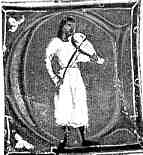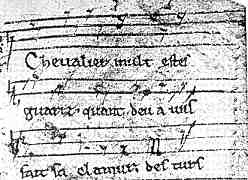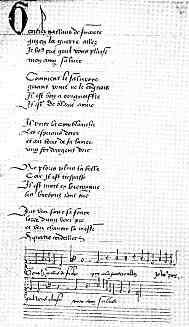




If you are looking at this page without frames, there is more information about medieval writing to be found by going to the home page (framed) or the site map (no frames).
| Music (2) | ||||
 |
A significant amount of secular medieval literature had origins in performance art, and that performance included singing. Lyric poetry and the romance ballads, or chansons de geste, which formed the basis for the development of written romance literature in elegant manuscript volumes, were designed to be sung. Manuscripts of such material often have little miniatures or initials showing the performers in action with their instruments. What these manuscripts mostly lack is any musical notation, implying that the musical component was a skill learned orally and part of the trained skills of the jongleur, rather than part of the developing culture of the written word. | |||
| A depiction of a jongleur, with his viol, in a historiated initial in a 13th century French volume of romance. | ||||
 |
||||
| A group of jongleurs in a page border of a 13th century Romance of Alexander (Paris, Bibliothèque National, fonds français, 24364). | ||||
| The above example shows both male and female performers with their instruments. | ||||
| When musical notation does appear, the techniques used for the Latin chants of the church have been appropriated to vernacular song. The example at right represents a segment from the oldest written French song, from 1146, an Anglo-Norman exhortation to get out and join the Second Crusade. There are different numbers of staves in each line of music and neumes of different shapes, and I guess we would need a musicologist to explain how it all works. |
 |
|||
| Song in Anglo-Norman dialect from 1146 (Erfurt, Bibliothèque). | ||||
 |
||||
| Sumer is icumen in from an early 13th century manuscript of Reading Abbey (British Library, MS Harley 978, f.11v). | ||||
| The above very famous example from a song in the form of a round is written in both English and Latin versions. The manuscript also has an explanation, in Latin, of how the round is to be sung. The cross represents the point at which the next singer joins in the round. The text of these versions is not related in any way, the Middle English version being a jolly celebration of the joys of summer, while the Latin is a contemplation of Christ's passion. It is not apparent whether the English words have been set to a religious tune, or the church has appropriated a secular ditty to their own purposes. The notation is the same as that used for liturgical works, and one must assume that the existence of the Latin version is the reason that this work has come into the corpus of manuscript music, rather than being lost with the oral tradition. | ||||
| Transcriptions and background information about Sumer is icumen in are provided on the web by the University of Southampton. | ||||
 |
Increasingly, vernacular songs were written with musical notation included, although for many texts known to have been sung, the music is lost forever. By the 15th century, popular songs were being written out in modest editions using the cursive and bastarda scripts of the period, with the music included. The notation of the example at left is starting to look more or less familiar, although this one employs six line staves. | |||
| A popular song of the 15th century, about a true love dead in the wars (Sigh!!) (Paris, Bibliothèque Nationale, MS franç. 12744). (Click on image for a larger view.) | ||||
| Even when the music is included, it simply delineates the melody for the singer. Depictions of musicians in manuscripts and on other forms of art tell us the medieval musicians deployed a wide variety of musical instruments, plucked blown or struck. Reconstructions of performances of medieval music are inevitably conjectural to a degree, extrapolating back from somewhat later "early music" arrangements that have been written down, and attempting to reconstruct the instruments and work out from a practical perspective how they can be played. The unaccompanied and tremulous renditions of the last traditional ballad singers, whose efforts just survived long enough to be recorded in modern times, surely represent a corrupted and largely lost tradition. | ||||
|
|
||||
|
|
||||
|
If you are looking at this page without frames, there is more information about medieval writing to be found by going to the home page (framed) or the site map (no frames). |
||||